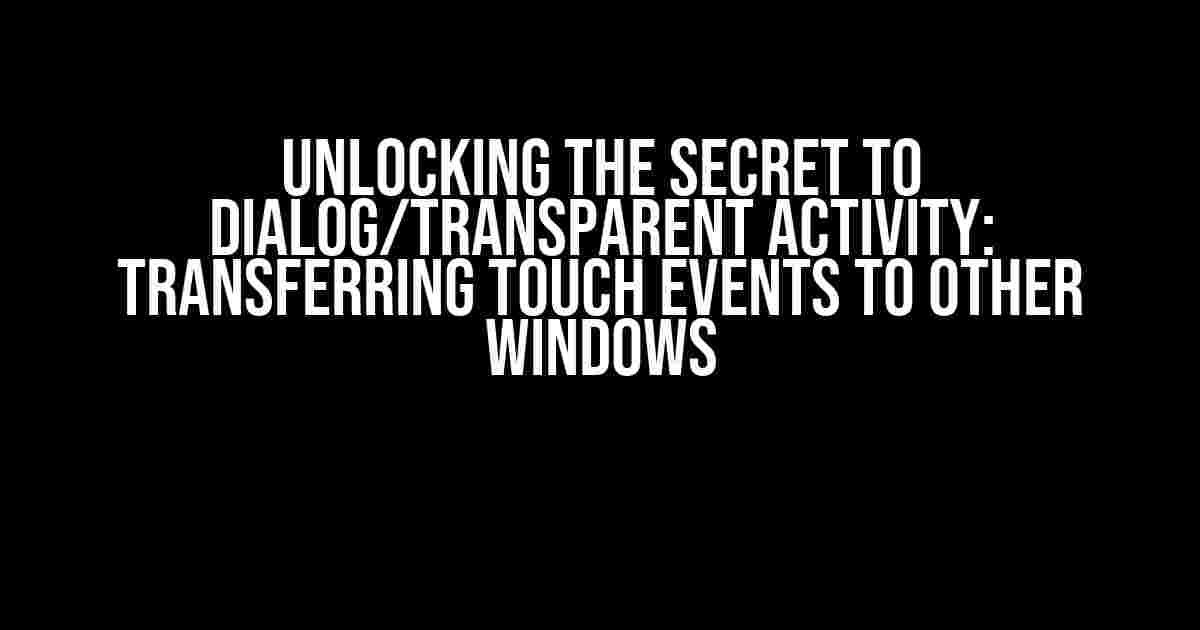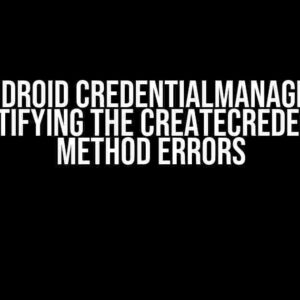Are you tired of dealing with pesky touch events getting lost in translation between your dialog/transparent activity and other windows? Do you find yourself wondering, “Is it possible to transfer touch events seamlessly?” Worry no more, dear developer, for we’re about to dive into the world of Android development and uncover the secrets to making this happen!
The Concept of Dialog/Transparent Activity
A dialog/transparent activity is a type of Android application window that allows users to interact with the underlying activity while still maintaining a sense of continuity. This is particularly useful when you need to display information or request user input without interrupting the user’s workflow. However, with great power comes great responsibility – and that’s where the challenge of transferring touch events to other windows comes in.
Understanding Touch Events in Android
In Android, touch events are an essential part of the user experience. When a user interacts with an app, the system generates a series of touch events, which are then dispatched to the relevant views and activities. But what happens when you have a dialog/transparent activity that needs to transfer these touch events to another window?
The answer lies in understanding the Android event system and how it handles touch events. When a touch event is generated, it’s passed down the view hierarchy, starting from the top-most view and working its way down. This means that if a dialog/transparent activity is on top of another window, it will receive the touch event first.
The Problem: Touch Events Getting Lost in Translation
So, why do touch events often get lost in translation between the dialog/transparent activity and other windows? The reason is simple: the default behavior of Android’s event system is to consume the touch event and prevent it from being propagated to other windows. This is done to ensure that the app responds correctly to user input and to prevent unexpected behavior.
However, in the case of a dialog/transparent activity, this default behavior can be a hindrance. You want to transfer the touch events to the underlying window, but the system is preventing it from happening. Fear not, dear developer, for we have a solution up our sleeve!
The Solution: Dispatching Touch Events to Other Windows
To transfer touch events from a dialog/transparent activity to another window, you need to override the default behavior of the Android event system. This can be achieved by using the `dispatchTouchEvent()` method, which allows you to manually dispatch touch events to other windows.
public class MyDialogActivity extends Activity {
@Override
public boolean dispatchTouchEvent(MotionEvent event) {
// Get the underlying activity
Activity underlyingActivity = getUnderlyingActivity();
// Check if the underlying activity is not null
if (underlyingActivity != null) {
// Dispatch the touch event to the underlying activity
underlyingActivity.dispatchTouchEvent(event);
}
// Return false to indicate that the event should be propagated further
return false;
}
}
In this example, we’re overriding the `dispatchTouchEvent()` method in our dialog/transparent activity to dispatch the touch events to the underlying activity. By returning `false`, we’re indicating that the event should be propagated further, allowing it to reach the underlying window.
Using the onInterceptTouchEvent() Method
Another way to transfer touch events to other windows is by using the `onInterceptTouchEvent()` method. This method is called when a touch event is generated, and it allows you to intercept and handle the event before it’s dispatched to the underlying views.
public class MyDialogActivity extends Activity {
@Override
public boolean onInterceptTouchEvent(MotionEvent event) {
// Get the underlying activity
Activity underlyingActivity = getUnderlyingActivity();
// Check if the underlying activity is not null
if (underlyingActivity != null) {
// Dispatch the touch event to the underlying activity
underlyingActivity.dispatchTouchEvent(event);
}
// Return true to indicate that the event should not be propagated further
return true;
}
}
In this example, we’re using the `onInterceptTouchEvent()` method to intercept the touch event and dispatch it to the underlying activity. By returning `true`, we’re indicating that the event has been handled and should not be propagated further.
Real-World Scenarios: When to Use Dialog/Transparent Activity
So, when should you use a dialog/transparent activity to transfer touch events to other windows? Here are some real-world scenarios to get you started:
- Image editors: Imagine an image editing app that allows users to select a region of the image and then apply effects. A dialog/transparent activity can be used to display the selection region, while still allowing the user to interact with the underlying image.
- Virtual keyboards: A virtual keyboard can be implemented using a dialog/transparent activity, allowing users to type on the keyboard while still interacting with the underlying app.
- Pop-up menus: A dialog/transparent activity can be used to display pop-up menus, such as context menus or overflow menus, while still allowing the user to interact with the underlying app.
- Gesture-based interfaces: A dialog/transparent activity can be used to create gesture-based interfaces, such as gestures for zooming or rotating, while still allowing the user to interact with the underlying app.
Best Practices and Considerations
When using a dialog/transparent activity to transfer touch events to other windows, there are some best practices and considerations to keep in mind:
- Performance: Dispatching touch events can be computationally expensive, so make sure to optimize your code and test for performance issues.
- Event handling: Be careful when handling touch events, as multiple events can be generated for a single user interaction. Make sure to handle events correctly to prevent unexpected behavior.
- Window focus: Ensure that the underlying window has focus when dispatching touch events, as this can affect how the events are handled.
- Activity lifecycle: Be aware of the activity lifecycle when using dialog/transparent activities, as this can affect how touch events are handled.
Conclusion
In conclusion, transferring touch events from a dialog/transparent activity to other windows is a powerful technique that can enhance the user experience in Android apps. By understanding the Android event system and using the `dispatchTouchEvent()` or `onInterceptTouchEvent()` methods, you can create seamless interactions between windows. Remember to follow best practices and consider performance, event handling, window focus, and activity lifecycle when implementing this technique.
| Method | Description |
|---|---|
| dispatchTouchEvent() | Dispatches the touch event to the underlying activity |
| onInterceptTouchEvent() | Intercepts the touch event and dispatches it to the underlying activity |
So, go ahead and unlock the full potential of dialog/transparent activities in your Android app development journey!
Frequently Asked Question
Get answers to the most commonly asked questions about dialog/transparent activity touch event to other window!
What is the main problem with Dialog/Transparent activity touch event to other window?
The main problem is that the touch event is not passed to the underlying window, causing the underlying window to not receive the touch events, making it difficult to interact with the underlying window.
How to pass touch event from Dialog/Transparent activity to other window?
You can use the `android:windowTouchSlop` attribute in your transparent activity’s theme to set the touch slop, and then override the `dispatchTouchEvent` method to pass the touch event to the underlying window.
What is the role of `android:windowTouchSlop` in passing touch event?
The `android:windowTouchSlop` attribute sets the distance in pixels a user’s finger must travel before the system considers it a swipe gesture, allowing the touch event to be passed to the underlying window.
How to override the `dispatchTouchEvent` method to pass touch event?
You can override the `dispatchTouchEvent` method in your transparent activity and call the `super.dispatchTouchEvent` method to pass the touch event to the underlying window, or use the `getWindow().getDecorView().dispatchTouchEvent` method to dispatch the touch event.
Are there any limitations or considerations when passing touch event to other window?
Yes, one limitation is that the transparent activity must be on top of the underlying window in the z-order, and another consideration is that the touch event may not be passed to the underlying window if the transparent activity has focus.


